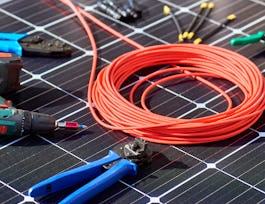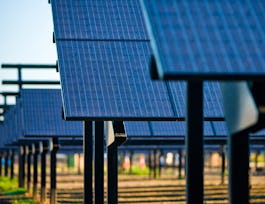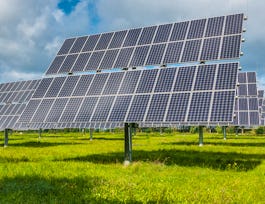Solar Energy System Design builds upon the introduction to PV systems from Solar Energy Basics course, which included basic system components and functions, as well as some basic system sizing using simplifying assumptions. You should at this point have a basic understanding of electrical power and energy, be able to calculate the energy needs of a site as well as energy production potential for a PV system at a given location under optimal conditions. Much of this course will focus on incorporating on the ground conditions into energy production considerations, and how to account for these conditions in system design and equipment selection. By the end of this course you should be able to incorporate losses in irradiance due to array setups with less than optimal positioning and/or shading, and account for variations in module output due to temperature variations in your system design.



Solar Energy System Design

Instructor: Neal Abrams
Sponsored by Coursera Learning Team
30,461 already enrolled
(430 reviews)
Recommended experience
Details to know

Add to your LinkedIn profile
17 assignments
See how employees at top companies are mastering in-demand skills


Earn a career certificate
Add this credential to your LinkedIn profile, resume, or CV
Share it on social media and in your performance review

There are 5 modules in this course
Welcome to the first module of Solar Energy System Design. In this module, you will be revisiting the solar resource in a bit more depth than the Solar Energy Basics course. This will entail looking more closely at some of the properties of sunlight, and what happens to that light as it travels from the Sun until it eventually reaches the Earth's surface.
What's included
8 videos1 reading4 assignments
We will now look closer at the circuits and electrical characteristics of modules and arrays. In Solar Energy Basics, you used module spec sheets to calculate power using voltage and current. In this module, you will be using those module specifications again, and looking at how the different voltage and current values included are important for determining how that module will operate under different conditions. Lastly, we will be looking at the design of both the internal circuitry of modules, and the circuitry of arrays of modules.
What's included
5 videos1 reading3 assignments
You calculated photovoltaic system sizes and outputs in Solar Energy Basics based on available insolation. Those insolation values were always based on the assumption of the array being set up at optimal conditions. On-the-ground conditions can often result in variations from the optimal design for capturing all the available insolation, such as the angle of a roof and the direction it is facing being fixed, or nearby trees casting shade onto part of an array. In this module you will learn how to account for the different sources of losses in insolation, because the overall productivity of a system design can change based on the positioning of the array, temperature variations, and shading on parts of the array. These variations in productivity need to be accounted for early in the planning phase of a PV system.
What's included
7 videos2 readings6 assignments
In the last content module of the course you will be working on equipment selection and system sizing. The previous modules on array siting, irradiance variability, temperature effects, shading losses, and circuit design will all come into play when you are designing a system. Additionally, you will be looking at site surveying, where those pieces of information are gathered, and permitting, where they are recorded and communicated along with the recommended system design.
What's included
5 videos2 readings4 assignments
The capstone project of this course will entail applying much of what you have learned in this course. You will need to design a PV system using commercially available components and calculate it's output under site specific conditions. You will have to account for the available solar radiation and losses due to the positioning of the array as well as due to shading. You will also need to design an optimal configuration to connect the PV modules with an inverter. Finally, you will evaluate a PV system design for both accuracy and safety.
What's included
1 peer review
Instructor

Offered by
Why people choose Coursera for their career




Learner reviews
430 reviews
- 5 stars
81.39%
- 4 stars
15.34%
- 3 stars
1.16%
- 2 stars
0%
- 1 star
2.09%
Showing 3 of 430
Reviewed on Sep 9, 2020
Teacher is very elaborative and explained each concept so nicely. Thankfully now i can design solar systems for net metering. Thanks Professor Neal Abrams and Coursera
Reviewed on Aug 26, 2021
Good content. The quiz will drive you crazy because some answers to the quizzes are wrong (check the discussion forum). Overall I learnt a lot, thank you!
Reviewed on Oct 27, 2020
The course is very focused and use of simple language and examples makes the concept pretty clear. Excellent content and you will end up with good knowledge on Solar Energy System.
Recommended if you're interested in Physical Science and Engineering

University at Buffalo

University at Buffalo

The State University of New York

Technical University of Denmark (DTU)

Open new doors with Coursera Plus
Unlimited access to 10,000+ world-class courses, hands-on projects, and job-ready certificate programs - all included in your subscription
Advance your career with an online degree
Earn a degree from world-class universities - 100% online
Join over 3,400 global companies that choose Coursera for Business
Upskill your employees to excel in the digital economy


